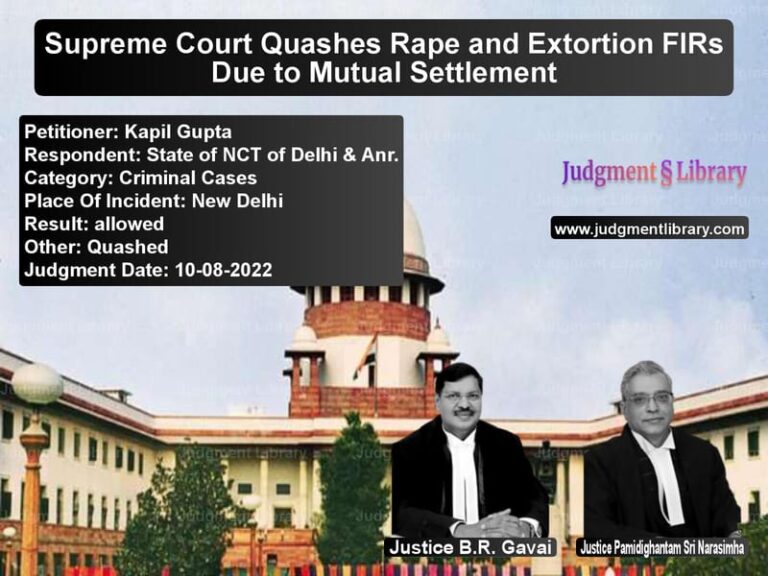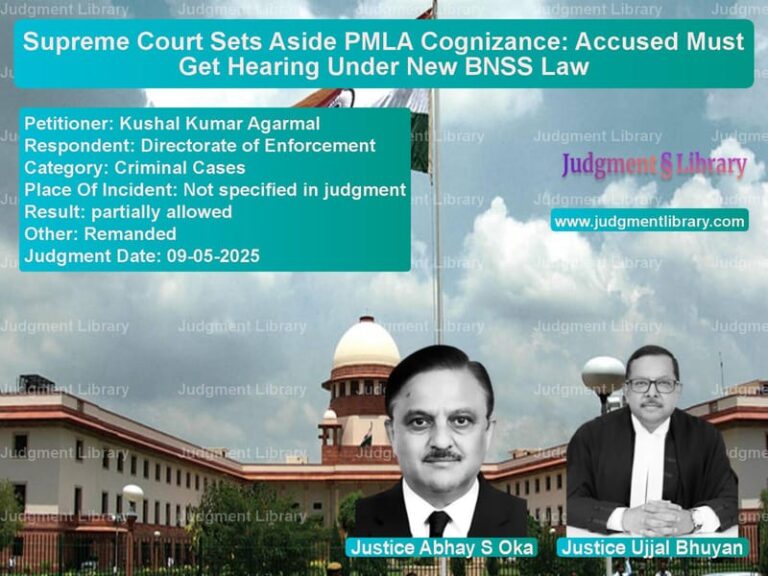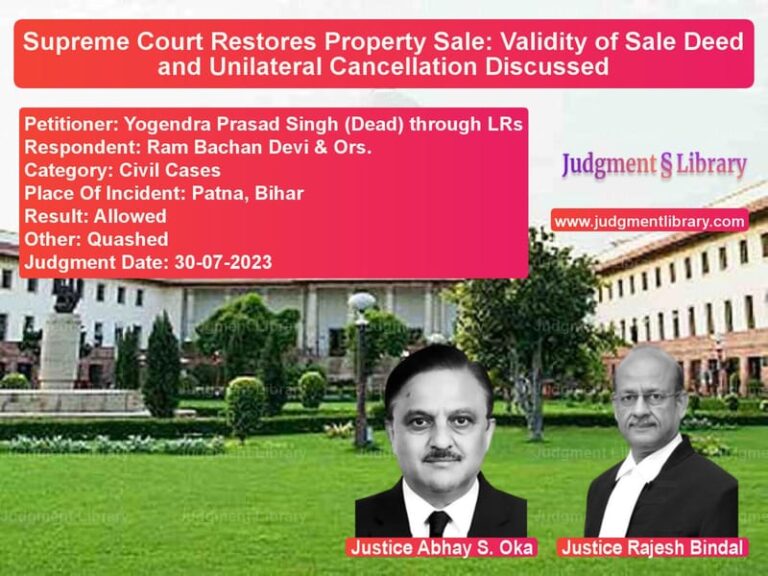Environmental Pollution and Accountability: Supreme Court Directs Urgent Measures for Delhi and NCR
The case of M.C. Mehta vs. Union of India & Ors. revolves around the alarming issue of environmental pollution in Delhi and the National Capital Region (NCR). The Supreme Court’s judgment addresses severe air and water pollution, the impact of stubble burning, and the accountability of government authorities in failing to prevent recurring pollution crises. The Court criticized the lack of timely action and issued comprehensive directions to mitigate pollution.
The Supreme Court highlighted the repeated failure of authorities to control pollution, leading to hazardous air quality levels affecting millions. The Court invoked the Right to Life under Article 21 of the Constitution, emphasizing that unchecked pollution violates citizens’ fundamental rights. The Court also addressed the severe pollution of rivers, primarily caused by industrial effluents and sewage dumping, underscoring the duty of state machinery to protect the environment.
Background of the Case
Environmental pollution in Delhi has been a long-standing issue, worsened by stubble burning in neighboring states, unchecked vehicular emissions, rampant construction activities, and ineffective waste management. The Court noted that despite multiple directions over the years, state governments and municipal authorities had failed to implement effective measures to control pollution.
The case stemmed from the broader environmental concerns raised by environmental activist M.C. Mehta. He approached the Supreme Court seeking strict enforcement of pollution control laws and holding authorities accountable for their failure to protect public health.
Petitioner’s Arguments
The petitioner, M.C. Mehta, argued:
- Pollution in Delhi had reached alarming levels, making it unfit for human habitation.
- The government and civic bodies had consistently failed to implement pollution control measures.
- There was a blatant violation of the Right to Life under Article 21 due to air and water pollution.
- Farmers in Punjab and Haryana continued to burn stubble despite court orders.
- Delhi’s waste management system was in complete disarray, leading to large-scale garbage burning.
- Industries were openly violating environmental norms, emitting toxic pollutants.
Respondent’s Arguments
The government, represented by the Union of India and the states of Delhi, Punjab, Haryana, and Uttar Pradesh, defended its actions, arguing:
- Efforts were being made to curb pollution through restrictions on stubble burning.
- Anti-pollution measures such as the odd-even vehicle scheme were implemented in Delhi.
- Monitoring mechanisms were in place to track air quality and enforce penalties.
- Funds had been allocated to provide farmers with alternative equipment for managing crop residue.
- Several measures, including waste segregation and industrial compliance, were underway.
Supreme Court’s Observations
The Supreme Court expressed its frustration at the inaction of state and central authorities. The Court made several critical observations:
“This is blatant and grave violation of the Right to Life of the sizeable population by all these actions. Scientific data indicates that the lifespan of people is being reduced due to this kind of pollution.”
The Court emphasized the need for immediate action, stating:
“Time has come when we have to fix accountability for this kind of situation which has arisen and is destroying the Right to Life itself in gross violation of Article 21.”
Key Directions Issued by the Supreme Court
1. Stubble Burning and Agricultural Pollution
- Punjab, Haryana, and Uttar Pradesh were directed to ensure a complete halt to stubble burning.
- The Chief Secretaries of these states were ordered to submit action plans within a fixed timeframe.
- Village Panchayats and Gram Pradhans were made responsible for ensuring compliance.
- A fine of Rs. 100 per quintal was imposed on stubble burning.
- Farmers were directed to use alternative residue management equipment.
2. Vehicular Pollution Control
- Delhi was instructed to review the effectiveness of the odd-even scheme.
- Restrictions on diesel vehicles entering Delhi were recommended.
- Random fuel quality checks on vehicles, including three-wheelers, were mandated.
3. Industrial and Construction Pollution
- Pollution Control Boards were directed to monitor industries emitting black smoke.
- Strict compliance with environmental norms in industrial areas was mandated.
- All construction and demolition activities were suspended in Delhi and NCR.
- Developers violating construction norms were to be penalized and blacklisted.
4. Waste Management and Open Burning
- Delhi and NCR authorities were directed to clear dumped waste immediately.
- Municipal bodies were ordered to provide 100% waste management capacity within three months.
- Garbage burning was strictly prohibited, with violators facing penalties.
5. Water Pollution and River Protection
- State governments were directed to curb industrial effluent discharge into rivers.
- Reports on sewage treatment and waste management were sought from all states.
- Random sampling of drinking water quality in Delhi was ordered.
6. Deployment of Technology to Combat Pollution
- Smog Towers were to be installed in Connaught Place and Anand Vihar.
- Anti-Smog Guns were mandated at large construction sites.
- New technologies such as Oxy Furnaces, Wireless Sensors, and Laser-based monitoring were recommended for industrial emissions.
Final Judgment
The Supreme Court directed the concerned governments to submit progress reports within a fixed timeframe. It warned:
“Failure to act will not be tolerated. If authorities fail to comply, they will be held accountable, and financial liability may be imposed.”
The Court ordered the presence of the Chief Secretaries of Punjab, Haryana, Uttar Pradesh, and Delhi in the next hearing, emphasizing:
“Why should the state machinery not be held responsible for compensating citizens who suffer due to their failure in preventing pollution?”
Key Takeaways
- State accountability: Governments were warned of potential financial liability for pollution-related damages.
- Strict compliance required: Authorities were given fixed deadlines to implement measures.
- Public health prioritized: Pollution was deemed a direct violation of the Right to Life.
- Emphasis on technology: Smog towers, anti-smog guns, and other innovations were recommended.
Conclusion
The Supreme Court’s judgment in this case serves as a landmark ruling on environmental accountability. By issuing strict directions and holding authorities responsible, the Court reaffirmed its commitment to safeguarding public health and the environment. This ruling sets a precedent for future cases concerning environmental negligence and governmental accountability.
Petitioner Name: M.C. Mehta.Respondent Name: Union of India & Ors..Judgment By: Justice Arun Mishra, Justice Deepak Gupta.Place Of Incident: Delhi and NCR.Judgment Date: 13-01-2020.
Don’t miss out on the full details! Download the complete judgment in PDF format below and gain valuable insights instantly!
Download Judgment: M.C. Mehta vs Union of India & Ors Supreme Court of India Judgment Dated 13-01-2020.pdf
Direct Downlaod Judgment: Direct downlaod this Judgment
See all petitions in Environmental Cases
See all petitions in Judgment by Arun Mishra
See all petitions in Judgment by Deepak Gupta
See all petitions in allowed
See all petitions in Modified
See all petitions in supreme court of India judgments January 2020
See all petitions in 2020 judgments
See all posts in Environmental Cases Category
See all allowed petitions in Environmental Cases Category
See all Dismissed petitions in Environmental Cases Category
See all partially allowed petitions in Environmental Cases Category







